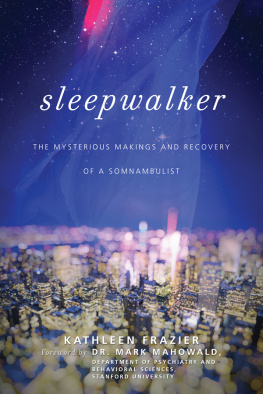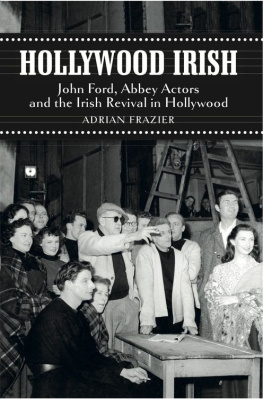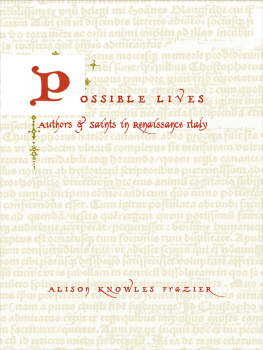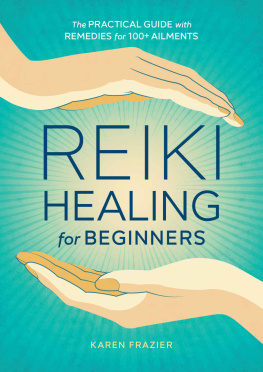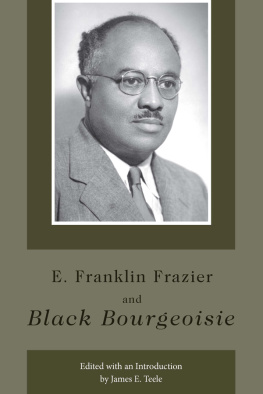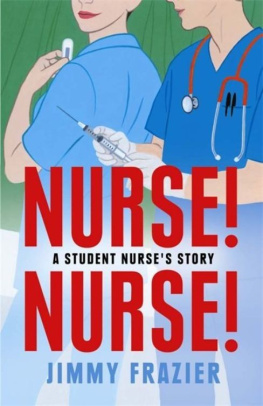Memoirs, by definition, are written depictions of events in peoples lives. They are memories. All the events in this story are as accurate and truthful as possible. Many names and places have been changed to protect the privacy of others. Mistakes, if any, are caused solely by the passage of time.
This book is not intended as a substitute for the medical advice of physicians. The reader should regularly consult a physician in matters relating to his/her health and particularly with respect to any symptoms that may require diagnosis or medical attention.
Copyright 2015 by Kathleen Frazier
All rights reserved. No part of this book may be reproduced in any manner without the express written consent of the publisher, except in the case of brief excerpts in critical reviews or articles. All inquiries should be addressed to Skyhorse Publishing, 307 West 36th Street, 11th Floor, New York, NY 10018.
Skyhorse Publishing books may be purchased in bulk at special discounts for sales promotion, corporate gifts, fund-raising, or educational purposes. Special editions can also be created to specifications. For details, contact the Special Sales Department, Skyhorse Publishing, 307 West 36th Street, 11th Floor, New York, NY 10018 or .
Skyhorse and Skyhorse Publishing are registered trademarks of Skyhorse Publishing, Inc., a Delaware corporation.
Visit our website at www.skyhorsepublishing.com.
10 9 8 7 6 5 4 3 2 1
Library of Congress Cataloging-in-Publication Data is available on file.
Cover design by Brian Peterson
Print ISBN: 978-1-63450-235-1
Ebook ISBN: 978-1-5107-0070-3
Printed in the United States of America
Have mercy on my memory, I sleepwalked through most of it.
CONTENTS
FOREWORD
THE DOCTORS OPINION
K athleen Fraziers powerful and beautifully written memoir successfully fills a huge void by providing helpful and valuable information on sleepwalking and sleep terrors by someone who is able to elucidate what these poorly understood phenomena are, how they are misinterpreted, and, most importantly, the extent to which they may greatly affect ones behavior and well-being.
For centuries, sleepwalking and sleep terrors were believed to be caused by diverse and usually undesirable phenomena such as acting out repressed waking desires, devil or demon possession, or psychiatric disease. One of the original terms for sleepwalking, moonstruck , brings to mind fictional creatures from gothic horror such as werewolves. Until recently, no effective treatments had been developed. It is highly likely that a good number of church-sanctioned exorcisms were, and still are, being performed for this medical condition.
Only recently has the underlying neurophysiology been explained. We now know that during sleepwalking and sleep terrors, the part of the brain that generates very complex behaviors is awake, while the part of the brain that normally monitors what we do and lays down memories of what we have done is asleep. This condition leaves the brain in a mixed wake/sleep state, capable of generating wild behaviors without conscious awareness and therefore without culpability. It is not known what causes this state dissociation (a mixture of wakefulness and sleep), but importantly, and contrary to popular opinion, it is not related to significant underlying psychiatric or psychological problems.
About one-third of American adults report having had an episode of sleepwalking. Yet sleepwalkers and those suffering from sleep terrors typically hesitate to seek medical attention. Still laboring under old ideas, they fear being told the episodes are due to psychiatric illness, and the nature of the episodes is often embarrassing. A potentially violent or injurious episode often leads to evaluation. Yet effective medical treatments are now availableactually a number of themsuch as medication and hypnosis. The key is finding a sleep medicine professional experienced in the diagnosis and management of sleepwalking and sleep terrors.
Sleepwalking and sleep terrors affected every part of Ms. Fraziers life. They put her safety, her very life, at risk and threatened the safety of those close to her. Sleepwalker: The Mysterious Makings and Recovery of a Somnambulist is an accurate and fact-filled account, offering hope to those suffering from sleepwalking or sleep terrors, their family members, and also to the professionals who work with them. More, her courage in honestly sharing her fascinating and moving story will appeal to allsleep being such an intimate and mysterious part of our human condition.
Mark W. Mahowald, MD
Former Director of the Minnesota Regional Sleep Disorders Center
Retired Professor, Dept. of Neurology, University of MN Medical School
Adjunct Professor, Department of Psychiatry and Behavioral Sciences, Stanford University
Consultant, Sleep Forensics Associates
My long nightgown twisted around my ankles. Id always hated that trapped feeling. I turned from side to side on the moldy couch in a ridiculous effort to get comfortable. The springs of the sofa were nocturnal animals. They poised patiently, waiting for the exact instant when my body surrendered to sleep so they could pounce up and bite me. I spent this particular night in the enormous living room of Bob and Janes apartment to avoid the smell of paint drying in my rented postage stamp of a bedroom. Deep blue had been my color choice, having read it could calm the nerves.
A month shy of twenty-nine, I was an aspiring actress resigned to communal living, one of several boarders in the rambling flat located on the Upper West Side of Manhattan. My landlords were middle-aged Bohemians, writers, filmmakers. He was a philanderer. Id played a Wild West saloon whore in a music video theyd made for a jazz saxophonist, which is how we became roommates. Their labyrinth halls led to disheveled rooms, some of which overlooked the Hudson with breathtaking views through windows left wide open in the unbearable summer heat.
Excruciatingly shy, I barely knew the names of the other tenants who wandered the hallways en route from their bedrooms to one of the many bathrooms. Some of them hardly left their quarters. Others came and went quickly, keeping odd hours. My room was in the back, off the kitchen, with a small, dirty window that faced an airshaft. Once the maids room, it included a closet-sized bathroom with toilet and sink. I hated having to shower or bathe in one of the larger bathrooms, shared with strangers.
If sharing a bathroom unnerved me, the idea of bunking down in an open, common space, through which one or more of them would pass during the course of the evening, horrified me. I especially cringed at the idea of Bob creeping past me in the middle of the night upon his return from a liaison.
Despite condemning myself as juvenile, Id plugged in my angel nightlight nearby. I wore my best nightgown, toolightweight and sleeveless but modest. Even in the dark, appearances mattered to me. It was the prettiest shade of rose pink, my mothers favorite flower. She was Catherine Rose and I wore it in her honor. It was August 6, 1988, and would have been her sixty-eighth birthday had she not died of cancer a little more than a year earlier. Id been attending a bereavement group at CancerCare the whole time, and it seemed to me that my grief should have eased after the one-year anniversary of my moms death. Instead it weighed heavier than ever.
Green glow-in-the-dark numbers on my radio alarm clock flipped in slow motion.
I turned on a reading lamp and the sudden light sent a cockroach scampering across the hardwood floor beneath a huge, discarded pile of newspapers. How would I ever fall asleep with the fear of the disgusting creatures crawling all over me at my most vulnerable?

